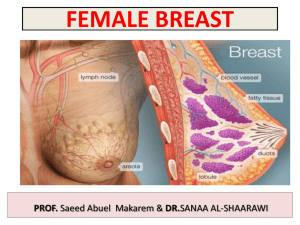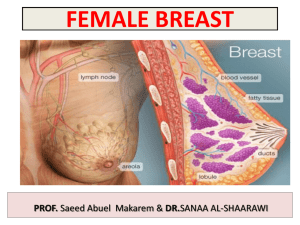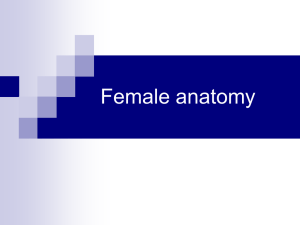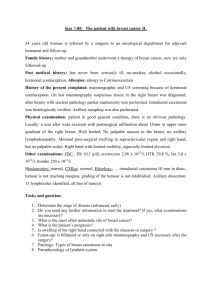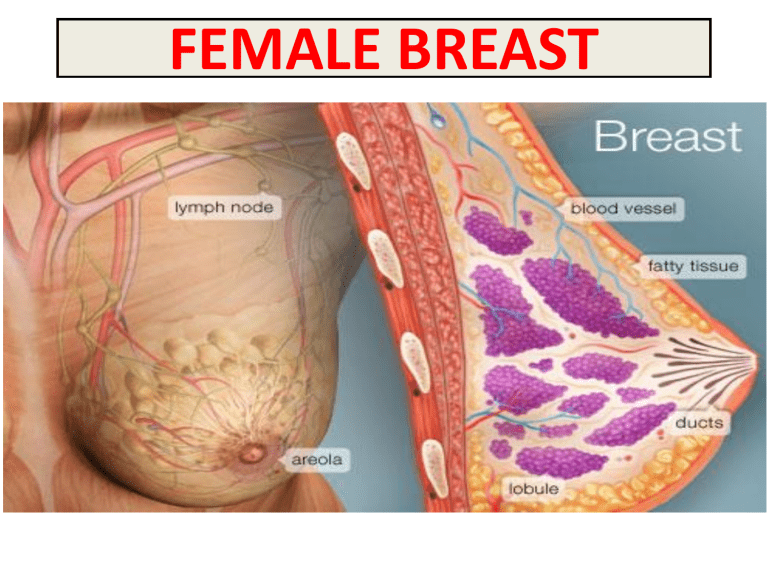
FEMALE BREAST OBJECTIVES • Describe the embryological development of the breast. • Describe the structure, composition and position of the breasts. • Describe the blood supply of the breasts. • Describe the nerve supply of the breasts. • Describe the lymphatic drainage of the breasts. Development of Mammary Glands • Are a modified and highly specialized type of apocrine sweat glands. • Consist of parenchyma, which is formed from ducts, and connective tissue stroma. • Parenchyma derives embryonically from surface ectoderm; stroma arises from surrounding mesenchyme. Development of Mammary Glands • Mammary buds develop as downgrowths from thickened mammary crests, which are thickened strips of ectoderm extending from the axillary to the inguinal regions Development of Mammary Glands Parts, Shape & position of the Gland • It is conical in shape. • It lies in superficial fascia of the front of chest. • It has a base, apex and tail. • Its base extends from 2nd to 6th ribs. • It extends from the sternum to the midaxillary line laterally. • It has no capsule. SHAPE AND POSITION OF FEMALE BREAST • 2/3 of its base lies on the pectoralis major muscle, while its inferolateral 1/3 lies on: • Serratus anterior & • External oblique muscles. • Its superolateral part sends a process into the axilla called the axillary tail or axillary process. SHAPE AND POSITION OF FEMALE BREAST • Nipple: • It is a conical eminence that projects forwards from the anterior surface of the breast. • The nipple lies opposite 4th intercostal space. • It carries 15-20 narrow pores of the lactiferous ducts. • Areola : • It is a dark pink brownish circular area of skin that surrounds the nipple. • The subcutaneous tissues of nipple & areola are devoid of fat. STRUCTURE OF MAMMARY GLAND • It is non capsulated gland. • It consists of lobes and lobules which are embedded in the subcutaneous fatty tissue of superficial fascia. • It has fibrous strands (ligaments of cooper) which connect the skin with deep fascia of pectoralis major. • It is separated from the deep fascia covering the underlying muscles by a layer of loose areolar tissue which forms the retromammary space. What is its Importance? (allows the breast to move freely). STRUCTURE OF MAMMARY GLAND • It is formed of 15-20 lobes. • Each lobe is formed of a number of lobules. • The lobes and lobules are separated by interlobar and interlobular fibrous & fatty tissue, called ligaments of Cooper. (Importance)? These ligaments give the breasts support by connecting the skin of the breasts to the pectoralis muscles below them. • It has from 15-20 lactiferous ducts which open by the same number of openings on the summit of the nipple. ARTERIAL SUPPLY • 1. Perforating branches of internal thoracic (internal mammary) artery. • 2. Mammary branches of lateral thoracic artery. • 3. Mammary branches of Intercostal arteries. VENOUS SUPPLY • Veins are corresponding to the arteries. • Circular venous plexus are found at the base of nipple. • Finally, veins of this plexus drain into axillary & internal thoracic veins. Nerve supply AXILLARY LYMPH NODES • They are arranged into 5 groups which lie in axillary fat : • Pectoral (Anterior) group : which lies on the pectoralis minor along lateral thoracic vessels. • Subscapular (Posterior) group : which lies on posterior wall of axilla on lower border of subscapularis along subscapular vessels. • Brachial (Lateral) group : lies on lateral wall of axilla along 3rd part of axillary vessels. • Central group : lies in axillary fat at the base of axilla. • Apical group : lies at apex of axilla. • Subclavian lymph trunk: • it is formed by union of efferent lymph vessels of apical group. It usually opens in subclavian vein. On the left side it usually opens into thoracic duct. LYMPHATIC DRAINAGE • Subareolar lymphatic plexus : • Lies beneath the areola. • Deep lymphatic plexus: • Lies on the deep fascia covering pectoralis major. • Both plexuses radiate in many directions and drain into different lymph nodes. LYMPHATIC DRAINAGE • Central & lateral parts of the gland (75%) drain into pectoral group of axillary lymph nodes. • Upper part of the gland drains into apical group of axillary lymph nodes. • Medial part drains into internal thoracic (parasternal) lymph nodes, forming a chain along the internal thoracic vessels. • Some lymphatics from the medial part of the gland pass across the front of sternum to anastomose with that of opposite side. • Lymphatics from the inferomedial part anastomose with lymphatics of rectus sheath & linea alba, and some vessels pass deeply to anastomose with the sub diaphragmatic lymphatics. APPLIED ANATOMY- CANCER BREAST • It is a common surgical condition. • 60% of carcinomas of breast occur in the upper lateral quadrant. • 75% of lymph from the breast drains into the axillary lymph nodes. • In case of carcinoma of one breast, the other breast and the opposite axillary lymph nodes are affected because of the anastomosing lymphatics between both breasts. • In patients with localized cancer breast, a simple mastectomy, followed by radiotherapy to the axillary lymph nodes is the treatment of choice. • The lactiferous ducts are radially arranged from the nipple, so incision of the gland should be made in a radial direction to avoid cutting through the ducts. • Infiltration of the ligaments of Cooper by breast cancer leads to its shortening giving an orange appearance of the breast. Applied Anatomy
